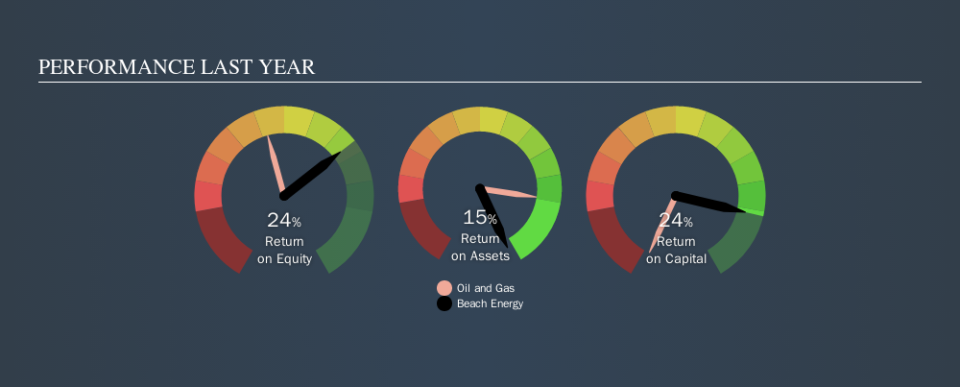Is Beach Energy Limited’s (ASX:BPT) 24% ROCE Any Good?

Today we'll look at Beach Energy Limited (ASX:BPT) and reflect on its potential as an investment. Specifically, we're going to calculate its Return On Capital Employed (ROCE), in the hopes of getting some insight into the business.
First, we'll go over how we calculate ROCE. Next, we'll compare it to others in its industry. Last but not least, we'll look at what impact its current liabilities have on its ROCE.
What is Return On Capital Employed (ROCE)?
ROCE is a measure of a company's yearly pre-tax profit (its return), relative to the capital employed in the business. Generally speaking a higher ROCE is better. Ultimately, it is a useful but imperfect metric. Author Edwin Whiting says to be careful when comparing the ROCE of different businesses, since 'No two businesses are exactly alike.
So, How Do We Calculate ROCE?
The formula for calculating the return on capital employed is:
Return on Capital Employed = Earnings Before Interest and Tax (EBIT) ÷ (Total Assets - Current Liabilities)
Or for Beach Energy:
0.24 = AU$805m ÷ (AU$3.9b - AU$613m) (Based on the trailing twelve months to June 2019.)
So, Beach Energy has an ROCE of 24%.
View our latest analysis for Beach Energy
Does Beach Energy Have A Good ROCE?
ROCE can be useful when making comparisons, such as between similar companies. Beach Energy's ROCE appears to be substantially greater than the 13% average in the Oil and Gas industry. We would consider this a positive, as it suggests it is using capital more effectively than other similar companies. Regardless of the industry comparison, in absolute terms, Beach Energy's ROCE currently appears to be excellent.
Beach Energy has an ROCE of 24%, but it didn't have an ROCE 3 years ago, since it was unprofitable. That implies the business has been improving. You can see in the image below how Beach Energy's ROCE compares to its industry. Click to see more on past growth.
When considering this metric, keep in mind that it is backwards looking, and not necessarily predictive. ROCE can be deceptive for cyclical businesses, as returns can look incredible in boom times, and terribly low in downturns. ROCE is only a point-in-time measure. We note Beach Energy could be considered a cyclical business. Future performance is what matters, and you can see analyst predictions in our free report on analyst forecasts for the company.
What Are Current Liabilities, And How Do They Affect Beach Energy's ROCE?
Liabilities, such as supplier bills and bank overdrafts, are referred to as current liabilities if they need to be paid within 12 months. The ROCE equation subtracts current liabilities from capital employed, so a company with a lot of current liabilities appears to have less capital employed, and a higher ROCE than otherwise. To check the impact of this, we calculate if a company has high current liabilities relative to its total assets.
Beach Energy has total assets of AU$3.9b and current liabilities of AU$613m. Therefore its current liabilities are equivalent to approximately 16% of its total assets. This is quite a low level of current liabilities which would not greatly boost the already high ROCE.
Our Take On Beach Energy's ROCE
With low current liabilities and a high ROCE, Beach Energy could be worthy of further investigation. There might be better investments than Beach Energy out there, but you will have to work hard to find them . These promising businesses with rapidly growing earnings might be right up your alley.
For those who like to find winning investments this free list of growing companies with recent insider purchasing, could be just the ticket.
We aim to bring you long-term focused research analysis driven by fundamental data. Note that our analysis may not factor in the latest price-sensitive company announcements or qualitative material.
If you spot an error that warrants correction, please contact the editor at editorial-team@simplywallst.com. This article by Simply Wall St is general in nature. It does not constitute a recommendation to buy or sell any stock, and does not take account of your objectives, or your financial situation. Simply Wall St has no position in the stocks mentioned. Thank you for reading.

 Yahoo Finance
Yahoo Finance 
